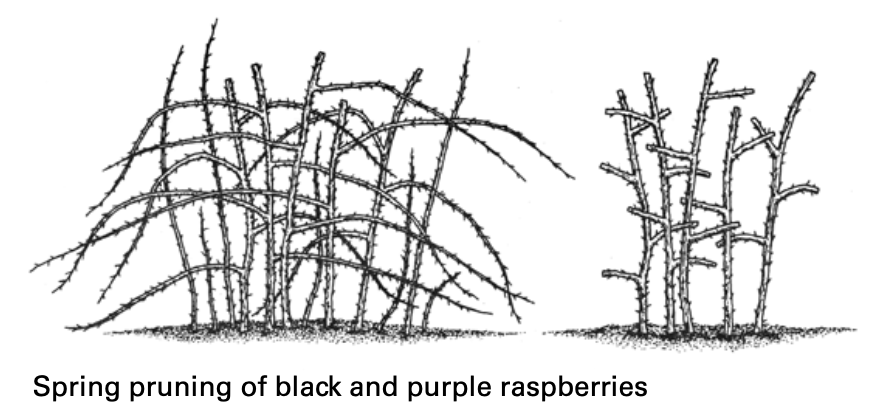A guide to pruning raspberries

The content of this article 'A guide to pruning raspberries' was prepared by Richard Jauron of Iowa State University and has been revised and republished by FreshFruitPortal.com.
To obtain maximum yields, raspberries must be pruned properly. Pruning produces higher yields by increasing berry size. It also helps control diseases. Pruning procedures are based on the growth and fruiting characteristics of the plants.
Growth characteristics
Raspberries are unique because their roots and crowns are perennial, while their stems or canes are biennial. A raspberry plant may survive and produce fruit for many years, however, individual canes live only two years and then die.
During the first growing season, the shoots of purple, black, and summer-bearing red raspberries are strictly vegetative (non-fruiting). The following year, these same canes flower, produce fruit, and then die.
Fall-bearing red raspberries naturally produce two crops. The first crop is produced in late summer or early fall at the tips of the current season’s growth. The following year, a summer crop is produced on the lower portions of these same canes. After the second crop, the canes die.
Red raspberries produce new canes from buds located at the base of the previous season’s growth and on their roots. Because red raspberries sucker freely, they need to be confined to a 1- to a 2-foot-wide hedgerow.
Black and purple raspberries produce new canes only from buds located at the base of the existing canes. As a result, they tend to remain in their original planting area.
The growth and fruiting characteristics of yellow raspberries are similar to red raspberries. The only difference is the fruit color.
How to prune summer-bearing red raspberries
In March or early April, remove all weak, diseased, and damaged canes at ground level. Leave the most vigorous canes, those approximately 1⁄4 inch in diameter when measured 30 inches from the ground.
When finished, the remaining canes should be spaced about 6 inches apart. Also, prune out the tips of the canes that have died due to winter injury. Cut them back to live tissue.
If the canes suffer little winter dieback, remove the top 1⁄4 of the canes. Maintain plants in a 1- to 2-foot-wide hedgerow using a rototiller or spade.
After the last harvest of summer, prune off the old fruiting canes at the soil surface. Remove the pruned material from the garden and destroy it.
How to prune fall-bearing red raspberries for two crops
In March or early April, remove all weak, diseased, and damaged canes leaving only the most vigorous canes. Also, prune out the tips of the canes.
Remove approximately the upper one-third of the canes. The summer crop will be produced on the lower portions of the canes. Maintain the plants in a 1- to a 2-foot-wide hedgerow.
After the summer crop has been harvested, remove the old fruiting canes and destroy them.
How to prune fall-bearing red raspberries for one crop
(Total crop yield is typically larger using the one-crop system versus the two-crop system.) In March or early April, prune all canes back to ground level. This eliminates the summer crop, but the fall crop matures one to two weeks earlier. Maintain the plants in a 1- to a 2-foot-wide hedgerow. No summer pruning is necessary.
How to prune yellow raspberries
Prune summer-bearing and fall-bearing yellow raspberries as you would their red raspberry counterparts.
How to prune black and purple raspberries
In March or early April, remove all of the small, weak canes, leaving only four or five of the largest, most vigorous canes per clump or plant. Cut back the lateral branches to 12 inches in length for black raspberries and 18 inches for purple raspberries.
 In late May begin to check on the height of the new raspberry shoots. Pinch out or cut off the shoot tips when the new growth reaches a height of 36 to 48 inches. Remove the top 3 to 4 inches of the shoots.
In late May begin to check on the height of the new raspberry shoots. Pinch out or cut off the shoot tips when the new growth reaches a height of 36 to 48 inches. Remove the top 3 to 4 inches of the shoots.
Pinching encourages lateral shoot development and increases the fruiting surface area, resulting in higher yields.
Since all of the new shoots will not reach the desired height at the same time, it will be necessary to go over the planting about once each week from late May to late July. Shoot tip removal can be discontinued at the end of July.
Canes that develop after July will be small, weak, and unproductive and should be pruned out the following spring.
After the last harvest of summer, prune off the old fruiting canes at the soil surface. Remove and destroy the pruned material.
Pruning equipment
Proper tools are required to prune raspberries. Sharp hand shears and lopping shears are excellent tools for pruning raspberries.
Source: Iowa State University











































